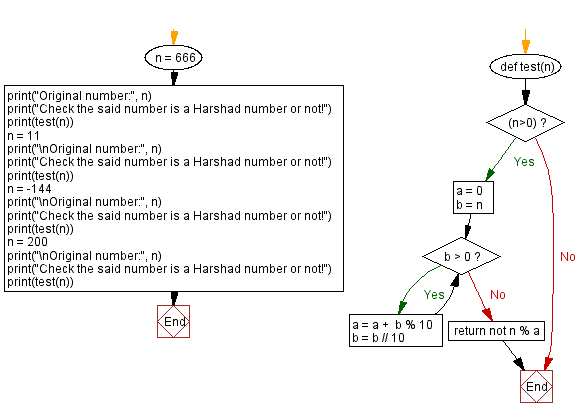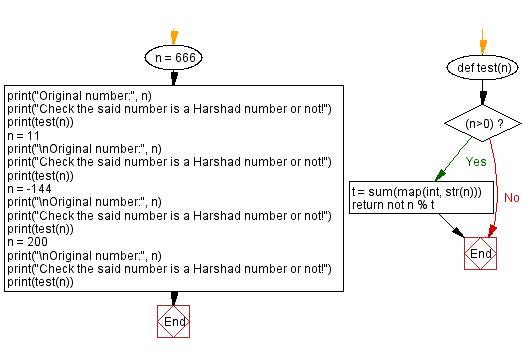Python Exercises: Check if a number is a Harshad number or not
90. Harshad Number Checker
In recreational mathematics, a Harshad number in a given number base, is an integer that is divisible by the sum of its digits when written in that base.
Example: The number 18 is a Harshad number in base 10, because the sum of the digits 1 and 8 is 9 (1 + 8 = 9), and 18 is divisible by 9.
The number 19 is not a harshad number in base 10, because the sum of the digits 1 and 9 is 10 (1 + 9 = 10), and 19 is not divisible by 10.
Harshad numbers in base 10 form the sequence:
1, 2, 3, 4, 5, 6, 7, 8, 9, 10, 12, 18, 20, 21, 24, 27, 30, 36, 40, 42, 45, 48, 50, 54, 60, 63, 70, 72, 80, 81, 84, 90, 100, 102, 108, 110, 111, 112, 114, 117, 120, 126, 132, 133, 135, 140, 144, 150, 152, 153, 156, 162, 171, 180, 190, 192, 195, 198, 200, ....
Write a Python program to check if a given number is a Harshad number or not. Return True if the number is Harshad otherwise False.
Sample Data:
(666) -> True
(11) -> False
(-144) -> None
(200) -> True
Sample Solution-1:
Python Code:
def test(n):
if (n>0):
a = 0
b = n
while b > 0:
a = a + b % 10
b = b // 10
return not n % a
n = 666
print("Original number:", n)
print("Check the said number is a Harshad number or not!")
print(test(n))
n = 11
print("\nOriginal number:", n)
print("Check the said number is a Harshad number or not!")
print(test(n))
n = -144
print("\nOriginal number:", n)
print("Check the said number is a Harshad number or not!")
print(test(n))
n = 200
print("\nOriginal number:", n)
print("Check the said number is a Harshad number or not!")
print(test(n))
Sample Output:
Original number: 666 Check the said number is a Harshad number or not! True Original number: 11 Check the said number is a Harshad number or not! False Original number: -144 Check the said number is a Harshad number or not! None Original number: 200 Check the said number is a Harshad number or not! True
Flowchart:

Sample Solution-2:
Python Code:
def test(n):
if (n>0):
t = sum(map(int, str(n)))
return not n % t
n = 666
print("Original number:", n)
print("Check the said number is a Harshad number or not!")
print(test(n))
n = 11
print("\nOriginal number:", n)
print("Check the said number is a Harshad number or not!")
print(test(n))
n = -144
print("\nOriginal number:", n)
print("Check the said number is a Harshad number or not!")
print(test(n))
n = 200
print("\nOriginal number:", n)
print("Check the said number is a Harshad number or not!")
print(test(n))
Sample Output:
Original number: 666 Check the said number is a Harshad number or not! True Original number: 11 Check the said number is a Harshad number or not! False Original number: -144 Check the said number is a Harshad number or not! None Original number: 200 Check the said number is a Harshad number or not! True
Flowchart:

For more Practice: Solve these Related Problems:
- Write a Python program to check if a number is a Harshad number by dividing it by the sum of its digits and printing True if divisible.
- Write a Python function that returns True if a number is Harshad and handles non-positive or non-integer inputs appropriately.
- Write a Python script to iterate over a list of numbers, determine which are Harshad numbers, and then print those numbers along with their digit sums.
- Write a Python program to prompt for a number and display whether it is a Harshad number, including input validation and error messages.
Go to:
Previous Python Exercise: Check a number is a repdigit number or not.
Next Python Exercise: Next number containing only distinct digits.
Python Code Editor:
Have another way to solve this solution? Contribute your code (and comments) through Disqus.
What is the difficulty level of this exercise?
Test your Programming skills with w3resource's quiz.
